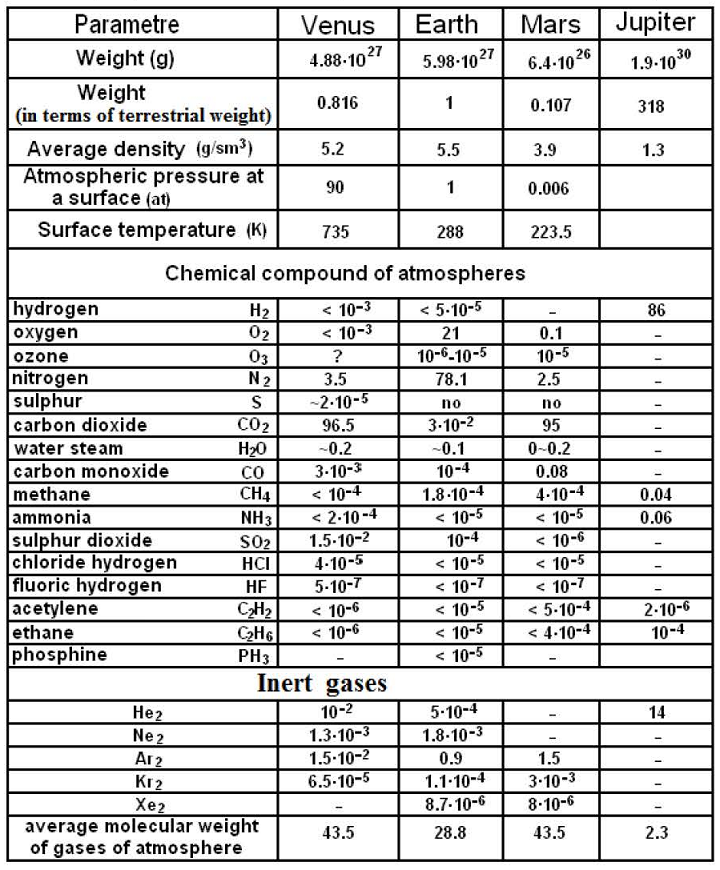While the planet is aging, the thickness of the peel is increasing, it’s capable of quench some of the vibrations and withstand stronger loads. The earthquakes become rarer, but their power grows stronger, and this process, perhaps, continues to the total cool down of the planet.
— The origin of life
The origin and development of life is one of the most complicated tasks that the scientists face. We’re not planning to create new theories about that matter. We’ll try to predict, how the conditions should have been evolving on Earth for life to start there.
What are the main parameters of the planet affect the origin and development of life?
1. The temperature on the surface of the planet and in the atmosphere.
If the temperature is lower or under the one in which the origin and development of life is possible – life won’t happen.
2. Chemical composition of the atmosphere – no more explanation needed.
3. Radiation situation on the planet.
The influence of this parameter is complicated and not works the same on different living organisms. More complicated organism affected by radiation to the worse. On less complicated organisms and plants the increasing radiation background has a good affects, the sizes of the organisms grow wider, the speed of growth and breeding as well. A large growth of radiation is dangerous for all organisms.
4. The existence of water.
Water is a chemical basis of most living organisms, and for many living organisms it’s the habitat. Water is also a universal, unaggressive solvent for many chemical compounds. It solves and misplaces chemical elements and compounds. For fulfilling its functions the water should be placed in liquid state, hence the changes of temperatures on the planet should provide the needed functioning of water.
5. Atmospheric pressure.
The gas pressure in the planet atmosphere is depending on the water state – liquid, solid or gaseous.
In order to continue our analysis, we have to find out the conditions of the planet before the life occurred, and in what way these conditions changed.
For defining the conditions on the planet we have to collect data about the conditions of planets with similar parameters to Earth. Unfortunately, we have information about only few planets, which won’t allow us to make large and objective analysis.
By which criteria we should pick planets?
If the planets used to be the kernels of stars, which means that the characteristics of the star should be reflected in the characteristics of the planet – its size and density and mass. Among the planets of the solar system the most suitable characteristics to Earth belongs the Venus and Mars.
Going forward and analyzing the planets parameters (their density, size, etc.), we can make an assumption that inner planets are the kernels of stars the merged in the center of the galaxy, and the Moon and outer planets merged in the sleeves of our galaxy. In table №Т-9.1 we have parameters and chemical compounds of Venus, Earth, Mars and Jupiter. As seen in the table, Venus and Mars have close to Earth parameters in terms of mass, size and density. Hence, Earth supposed have a similar chemical composition of the atmosphere before the origin of life.
Perhaps that the stars, in the bowels of which these planets were created also had similar to each other characteristics.
Venus has high surface temperature, which has to affect the chemical structure of the atmosphere.
(157) TABLE №T–9.1 (source «Planets», V. Morozov)
By increasing the temperature, the consistency of some connections in the atmosphere also increases, it is viewable on table №Т-9.1.
On Venus, in the atmosphere there high sulfur content (S), ammonia (NH3) and sulfur dioxide (SO2). Low content of oxygen in the atmosphere can be explained by the high temperature, which increasing the amount and speed of oxidizing. Let’s look on the main chemical components of Venus, Mars and Earth.
Carbon dioxide (carbon dioxide) in the atmosphere:
Venus — 96.5%
Mars — 95%
Earth — 3%
Nitrogen:
Venus — 3.5%
Mars — 2.5%
Land — 78.1%
Oxygen:
Venus — less than 10 -3% (0.001%)
Mars — 0.1%
Land — 21%
By comparing the chemical compositions of the atmospheres of Venus, Mars and Earth we can conclude that the chemical composition of the Earth atmosphere, before the origin of life, was close to those of Venus and Mars. The main chemical components were:
— Carbon dioxide (carbon dioxide) CO2 — 95-97%;
— Nitrogen N2 — 2.5-3.5%;
— Oxygen O2 — 0.001 — 0.1%;
— Water vapor H2O — 0 ~ 0.2%;
— Carbon monoxide CO — 0.003 ~ 0.08%;
— Other gases — less than 1%.
In order for the wildlife and human to appear, there was necessity for evolution of the Earth atmosphere. This means, the atmosphere had to change into its current chemical composition.
— Carbon dioxide CO2 — 0.03%;
— Nitrogen N2 — 78.1%;
— Oxygen O2 — 21%
— Carbon monoxide CO — 10.4%;
— Other gases are less than 1%.
Major changes in the atmosphere of the planet:
— Reduction of CO2 with 95-97% to 0.03%;
— Increasing the nitrogen N2 with 2.5 — 3.5% to 78.1%;
— Increase oxygen O2 with 0.001 — 0.1% to 21%.
Only such a change in the chemical composition of the atmosphere will create conditions for the emergence of wildlife on the planet.


